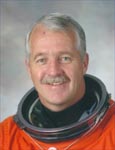RSC
Energia bio
(Jan 05) |
 John
Lynch PHILLIPS (Ph.D.) John
Lynch PHILLIPS (Ph.D.)
ISS Flight Engineer
Soyuz TMA TS Flight Engineer
NASA Astronaut, USA
DATE AND PLACE OF BIRTH: Born April 15, 1951 in Fort Belvoir, Virginia,
but considers Scottsdale, Arizona, to be his hometown.
EDUCATION:
Graduated from Scottsdale High School, Arizona, in 1966. He was the
second of 906 graduators who graduated from the U.S. Naval Academy in 1972
and received a bachelor of science degree in mathematics and Russian. In
1974 he received a master of science degree in aeronautical systems from
the University of West Florida and a master of science degree and a doctorate
in geophysics and space physics from the University of California, Los
Angeles, in 1984 and 1987 respectively.
FAMILY STATUS: Married to the former Laura Jean Doell. They have two
children.
HONORS: Within the scientific body he received 2 NASA Group Achievement
Awards for contributions to the Ulysses Spacecraft Mission and also the
Los Alamos National Laboratory Distinguished Performance Award in 1996.
Awarded the NASA Space Flight Medal and various military awards.
HOBBY: Skiing, kayaking, hiking, fitness activities and family recreation.
WORK EXPERIENCE:
In 1972 Phillips began service in the U.S. Naval Forces and in November
1974 he was designated a Naval Aviator. He trained in the A-7 Corsair Aircraft
at the Naval Air Station Lemoore, California. Then he served in Attack
Squadron 155 and made combat deployments aboard the USS Oriskany and USS
Roosevelt. After this be was engaged in navy recruiting in Albany, New
York, and flied the CT-39 Sabreliner Aircraft at Naval Air Station North
Island, California.
He has logged over 4300 flight hours and performed 250 carrier landings.
From 1982 to 2002 he served as a Navy reservist, as an A-7 pilot and in
various non-flying assignments.
He retired in 2002 with the rank of Captain, USNR.
After leaving the Navy in 1982, Phillips enrolled as a graduate student
at the University of California, Los Angeles, where he was engaged in data
processing which was obtained by the NASA Pioneer Venus Spacecraft. Upon
completing his doctorate in 1987, he was awarded a J. Robert Oppenheimer
Postdoctoral Fellowship at Los Alamos National Laboratory in New Mexico
and in 1989 he accepted a career position at Los Alamos. While there, Phillips
performed research on the Sun and the space environment. From 1993 through
1996 be was Principal Investigator for the Solar Wind Plasma Experiment
aboard the Ulysses Spacecraft passed over the poles of the Sun.
John Phillips has anthored 156 scientific papers dealing with the plasma
environment of the Sun, Earth, other planets and comets and spacecraft
as well.
In April 1996 he was selected as an astronaut candidate by NASA. In
1998 he completed astronaut candidate training at the Johnson Space Center
and was qualified as a mission specialist. After this be worked at the
NASA Astronaut Office and was involved with systems engineering. Phillips
was CAPCOM for the International Space Station.
On September 28, 2000 he was assigned to STS-100 crew.
From April 19 to May 1, 2001 he performed his first space flight as
a mission specialist of STS-100 Endeavour with Multi-Purpose Logistics
Module Raffaello. The main flight task was to deliver new equipment and
cargoes to the International Space Station for Expedition-2 and also to
deliver and install the Canadarm-2 Robotic Arm (SSRMS) at the external
surface of the Station.
The flight duration was 11 days, 21 hours, 50 minutes and 00 sec.
Phillips is currently training for ISS Expedition-11 as ISS flight
engineer and scientific specialist.
January 2005.
Based on Lyndon B. Johnson Space Center data, NASA, USA. |
|



 John
Lynch PHILLIPS (Ph.D.)
John
Lynch PHILLIPS (Ph.D.)